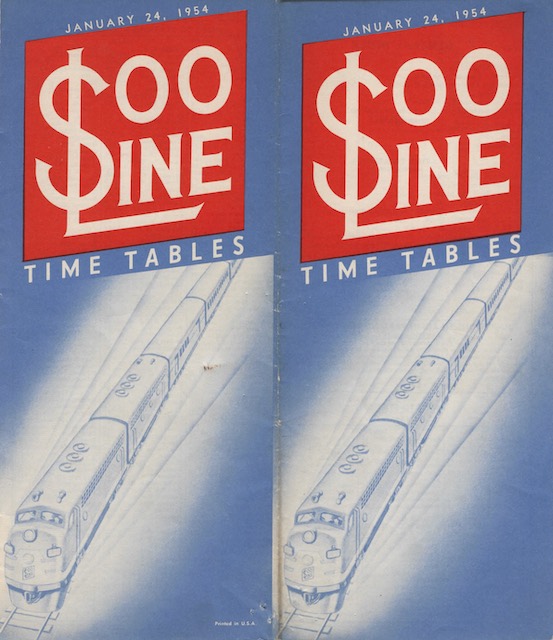“The Soo Line was never a major carrier of passenger traffic,” says Wikipedia, “since its route between Chicago and Minneapolis was much longer than the competing Chicago, Milwaukee, St. Paul and Pacific Railroad (Milwaukee Road), Chicago and North Western Railway, and Chicago, Burlington and Quincy Railroad (Burlington Route) routes.” The last part of this statement is correct: the Soo Line route was 460 miles vs. 407 on the North Western, 421 on the Milwaukee, and 437 on the Burlington. But the Soo didn’t even try to compete: while the other railroads were running trains between Chicago and Minneapolis in 6-1/2 hours, the Soo Line in 1954 took 15 hours (14-1/2 eastbound).
 Click image to download a 13.1-MB PDF of this timetable from the Ellery Goode collection.
Click image to download a 13.1-MB PDF of this timetable from the Ellery Goode collection.
The other part of Wikipedia’s declaration is more questionable, as Soo had a lot more routes than just Chicago-Minneapolis. Its premiere train was the Soo-Dominion (in other years known as the Mountaineer), which went from the Twin Cities to the Canadian border at Portal, North Dakota, then continued on the Canadian Pacific to Moose Jaw, where it joined the Dominion from Toronto and proceeded to Vancouver, BC.
It also offered the Winnipeger, which went from St. Paul to Winnipeg in 12-1/2 hours. It competed directly with Great Northern’s Winnipeg Limited, whose route was 7 miles shorter and which made the trip in 11-1/3 hours. Since both were overnight trains, the extra 70 minutes wasn’t hugely significant. More significant was the fact that GN’s train was mostly streamlined while the Winnipeger was mostly heavyweight.
The Soo Line was more competitive between Chicago and Duluth, where its route was only 1 mile longer than the North Western’s. In 1954, C&NW’s Duluth-Superior Limited managed the trip in 13-1/2 hours, while Soo’s Laker required 13-3/4 hours. Again, being overnight trains, 15 minutes wouldn’t have mattered much to passengers. What the North Western had that the Soo didn’t have was a second daily train between the two cities.
Great Northern, Northern Pacific, and Soo agreed to pool their passenger operations between the Twin Cities and Duluth-Superior. This meant revenues were split between them no matter whose line someone rode. However, in 1954 GN and NP each offered two trains a day while the Soo only had one (which probably meant it got 20 percent of the revenues). Soo had the only mid-day northbound train, which probably got a lot of business, but its southbound train left just a half hour before Northern Pacific’s and arrived in St. Paul four minutes after NP’s. GN had the dominant operation as its trains were the only ones on the route with a lounge car.
Soo probably had a monopoly on passenger service between the Twin Cities and its namesake, Sault Saint Marie. It still didn’t try very hard, taking 16-1/3 hours to go just over 500 miles for an average speed of less than 31 miles per hour.
The CP-owned railroad offered plenty of other trains as well: Twin Cities-Bismarck, Chicago-Ashland, Milwaukee-Argonne, and several even more obscure routes. It had two trains a day going the 6.7 miles between Cameron and Rice Lake, Wisconsin, and one a day the 3.9 miles between Dresser and St. Croix Falls, Wisconsin. Most of these trains, which went 6 days a week, would soon be replaced by buses or simply terminated.
So perhaps Wikipedia was right. As of 1954, Soo had lots of trains, but doesn’t appear to have competed very hard for traffic and so probably carried far fewer passengers than whoever its competitors were on various routes.
